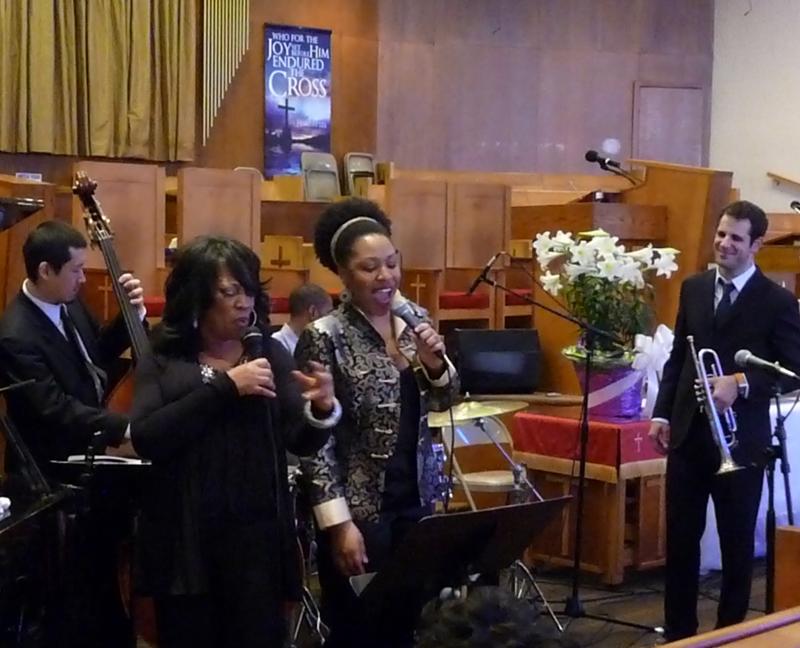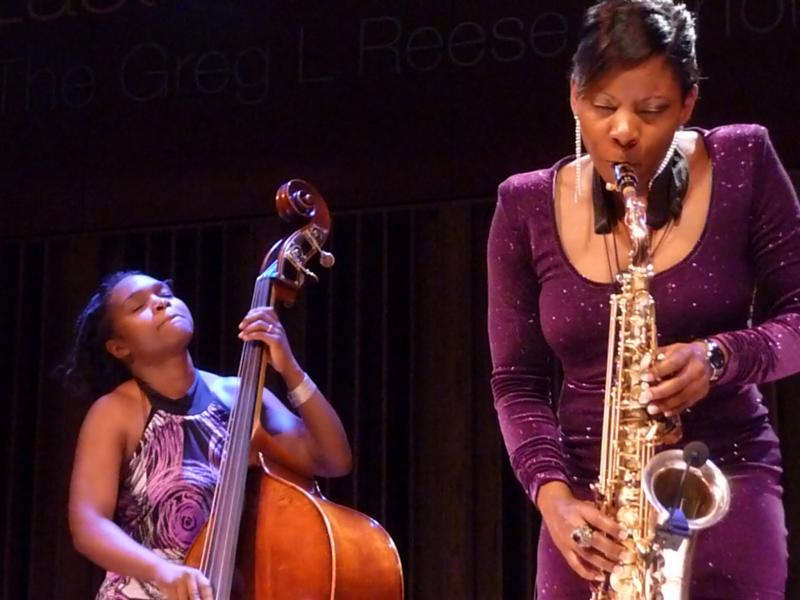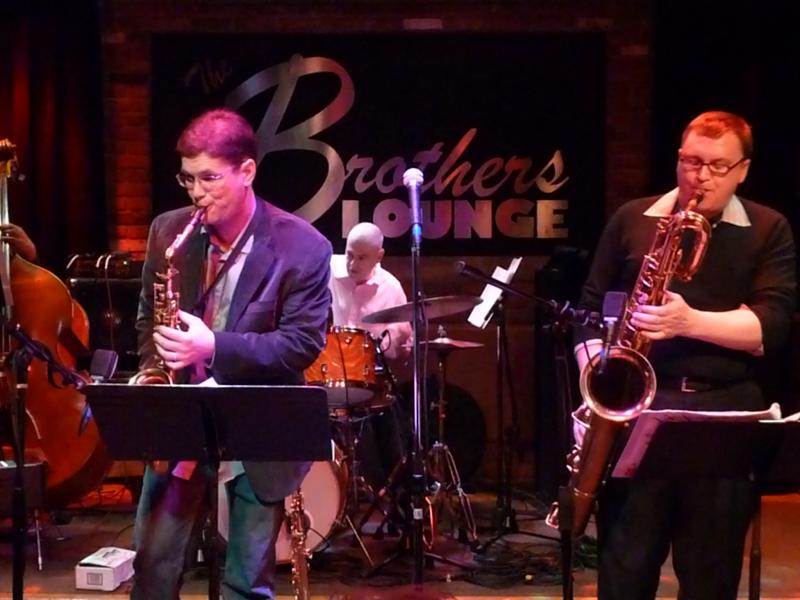Home » Jazz Articles » Live Review » Tri-C JazzFest Cleveland 2011: Days 4-6
Tri-C JazzFest Cleveland 2011: Days 4-6
32nd Annual Tri-C JazzFest Cleveland
Cleveland, Ohio
April 28-May 8, 2011
Chapter Index
- April 30: Women in Jazz: a Tribute to Betty Carter
- May 1: Ambrose Akinmusire Quintet / Tia Fuller Quintet
- May 1: Maurice Brown
- May 2: The Dave Sterner Quintet
April 30: Women in Jazz: a Tribute to Betty Carter
The JazzFest's yearly Women in Jazz program has become so popular that it needed to move a couple miles south this year, from the Mt. Zion Congregational Church to the much roomier Olivet Institutional Baptist Church, which, thankfully, also provided ample parking. And the acoustics were just as good, if not better, in the new locale. This time out, the program paid tribute to Betty Carter, and featured, as always, Cleveland's premier jazz singer Evelyn Wright. She was joined, however, not by other female singers from the area as in years past, but by Charenee Wade, an alum of Betty Carter's Jazz Ahead program and 1st runner-up at the 2010 Thelonious Monk International Jazz Competition.
 From left: Evelyn Wright, Charenee Wade, Dominick Faranacci
From left: Evelyn Wright, Charenee Wade, Dominick FaranacciNortheast Ohio-native trumpeter Dominick Faranacci led an energetic quartet to back the singers, opening the set in fine, dramatic fashion by parading up the aisle from the back of the church, blowing his trumpet to the heavens and stopping halfway to solo in the blue light coming through the stained glass. Upon joining his band, the group broke into "Willow Weep for Me," which featured a hard pounding piano solo with classical flourishes from Aaron Diehl—the type of solo he would continue to release, with lively effect, throughout the afternoon. Wright joined the band and ran through a set of standards, employing her rich, bluesy tone through nicely stretched vowels and twisted vocal lines. Highlights included "The Good Life," which started as a duet between Diehl and Wright, lifted into a Latin beat, and ended with a trading of scat and trumpet calls, and "But Beautiful," in which Diehl and Wright came into full communion by fashioning a sentimental but substantial rendering. Singer John Norton joined Wright for a Betty Carter/Ray Charles take on "Two to Tango," and pianist Dave Thomas came to the bandstand (rather unexpectedly, it seemed) to lead the band through a rousing, pianistic showcase on "Sweet Georgia Brown."
After an intermission, the band returned with Wade, whom Wright earlier boasted, "Is Betty Carter." And, without a doubt, Wade revealed a style heavily influenced by Carter and by Sarah Vaughan. Running through standards, plus lesser-known tunes like "Open the Door" and "Amazon Farewell," Wade showed herself as the possessor of all the spunk and humor of her two esteemed predecessors—the penchant for having fun with a lyric and playing with melody and harmony the way an instrumentalist would. "Amazon" wowed with Wade scatting to bassist Yasishi Nakamura's opening flurries, while Diehl swiped and plucked spooky jungle noises from the piano's strings. As the tune picked up, drummer Lawrence Leathers' sticks tapped quickly against the snare's rim, and Diehl adopted a Sun Ra-like vamping to support Wade's powerful, if largely indecipherable vocals. Faranacci's flugelhorn, which had shed tears elsewhere in the program, raced through a warning diatribe. At the close, Wade's vocals became crystal clear: "Stop! Don't cut down no more trees!" "Ruby, My Dear" also thrilled with Wade fully in Vaughan mode and Diehl adopting a spot-on Monk style. Wright returned to the stage for an encore duet with Wade on "Babe's Blues," a nicely handled showstopper that featured a friendly scatting competition between the two ladies.
May 1: Ambrose Akinmusire Quintet / Tia Fuller Quintet
Long a bedrock of the Tri-C JazzFest, typically presenting free shows on both weekends of the festival, the Greg L. Reese Performing Arts Center at the East Cleveland Library played a reduced role this year. It lit its stage for this one Saturday afternoon program only. But what a program.
 Ambrose Akinmusire
Ambrose Akinmusire Part of the festival's yearly Debut Series, the program offered a double bill of up-and-comers Ambrose Akinmusire and Tia Fuller. Trumpeter Akinmusire hit the bandstand first with his quintet to run through five original tunes (four of his own, one by his bassist Harish Raghavan), culled primarily from the trumpeter's 2011 Blue Note Records debut, When the Heart Emerges Glistening, released several weeks earlier. The show was capped by an extended, literally show stopping drum solo. Though Akinmusire's name springs from many a jazzer's lips these days when asked about the next big noise, he showed nothing of inflated swagger. In fact, judging by the slightly embarrassed dismissal of the birthday wishes thrown his way (he turned 29 the day of the show) by Fuller and Willard Jenkins, one gets the impression Akinmusire wants nothing to do with the hype, but just wants to play and let his horn do the boasting.
Over the course of the hour-long set, Akinmusire displayed a patience and wisdom in his playing that would be the envy of many musicians twice his age. He exercised complete command of his art, controlling the tone, tenor and dynamic of his playing to breathtaking effect. Far from fearing pauses, he made judicious use of spaces during his solos—especially in their nascent stages—taking care to bend, mold and nurture the character of his lines before sending them on to greater heights. And even when firing in the full heat of action, his playing retained a vibrant, authentic character, a singular voice that's likely to become one of the most dominant in jazz in the years to come.
Yet he wasn't alone on this afternoon, and his mates certainly deserve mention. Pianist Sam Harris, tenor saxophonist Walter Smith III, bassist Harish Raghavan and drummer Justin Brown all contributed—both individually and as a group—to fashioning an enthralling show of post-bop jazz. Brown was especially impressive, thundering with an aggressive intricacy that rarely let up, and single-handedly constructing the set's final number. Not only did his drumming surge with a constant propulsion during the piece, but the propulsion was constantly musical, biting at the heels of melody. JazzFest crowds love their drummers, and after this final song-length tune from Brown's singing trap set, the crowd was beside itself over its new drumming discovery.
Following this moving, complex and explosive set left saxophonist Tia Fuller in no enviable position, but she gamely strode on stage (in an act of five-inch-spiked-heel, bipedal daredevilism, no less) blowing her horn and touting a creed of "faith not fear." And in this spirited manner, Fuller brought the music in line with her own needs. She built the set around a handful of tunes from her 2010 release Deceptive Steps (Mack Avenue) and the title track from her sophomore effort, Healing Space (Mack Avenue, 2007). Much as trumpeter Maurice Brown would do later that evening in his set at Nighttown, Fuller made a point of developing a specific theme during the show. She came to the mike before each number (as Brown would also do) to make known her intentions for the movement that was to follow. She offered not only the expected set-up (relaying that "Healing Space" was composed in the aftermath of Hurricane Katrina, for example) but even went so far as to deconstruct "Ebb & Flow," explaining that Mimi Jones' bass line on the tune represented the ebb—the negative pull in life—while her sax melodies stood in for the positive flow.
 From left: Mimi Jones, Tia Fuller
From left: Mimi Jones, Tia FullerThere can be problems with taking such an approach, not the least of which is the possibility of missing the pronounced target. Fuller's lines on "Ebb & Flow," for instance, weren't especially flowing. And such a disconnect points to another problem, because both musician and audience can feel hemmed in by the prescribed musical range. Still, Fuller mostly kept it vague enough, with nods to positivity and perseverance, that her joyful saxophonic phrases had little trouble shining through, blossoming enough even to allow some nagging complaints to grumble out from the flower's center, and for regrets and wishes to whisper on the fringes of a glad breath. Jones sounded wholly in line with Fuller's soulful groove, while the saxophonist's sister, pianist Shamie Royston, often altered directions with her more angular bop approach. Drummer Shirazette Tinnin kept the percussive stream alive from the preceding set, and had her own go at a pulse-quickening closing solo on "Breakthrough," a piece for which Akinmusire was pulled from his rest, in red stocking feet no less, to lend a trumpeted hand.
May 1: Maurice Brown
Later that evening, the JazzFest faithful packed into Nighttown's music room for another free program featuring trumpeter Maurice Brown's quintet. Sporting a red suede jacket with the likeness of Jimi Hendrix stamped on its back, Brown led his crew through the better part of his 2010 album, The Cycle of Love (Brown), playing the record's first six tunes in order before breaking to "It's a New Day," from Hip to Bop (Brown, 2004), then returning to Cycle's title track and "Daydreams."
 Maurice Brown
Maurice BrownTrue to his Mo' Better nickname, Brown's compositions offered in their melodies a pleasing Branford Marsalis-style flavor. The solos then reached for the rafters, with both Brown and saxophonist Chelsea Baratz looking to raise voices and bodies from Nighttown's tables. Brown proved the more effective. For while Baratz's solos were indeed spirited, they were also more or less of a piece as she predictably ran through changes. Brown wailed and blared with a more diverse attack, showing off wild, technical skill—sometimes thrillingly so, other times in self-serving (rather than music-serving) blasts. Pianist Chris Rob offered up some of the evening's most interesting passages, with complex yet lyrical touches that recalled Robert Glasper's playing. Rob took to the mike on "The Cycle of Love," bending the show toward R&B with his smooth vocals. This after he'd stoked some call-and-response crowd participation on the preceding "Hip to Bop." He went back to the crowd on the encore, a wonderfully inventive take on Ellington's "The Mooche." "Do you feel the spirit?" he sang after some high-end pianistic scrambling and a break for Baratz's best solo of the night. Say "hip hop!" Rob then instructed, before cutting into a rap. Later, he tempted Brown into an extended rap that had both the band and its crowd happily moving. It had the feeling of a band finally breaking loose from self-imposed bonds to play the true music of its heart. Brown & Co. never sounded fresher than at the close.
May 2: The Dave Sterner Quintet
Saxophonist Dave Sterner's show at Brothers Lounge on Cleveland's West Side had the feel of a late '50s hard-bop club date, if with greater—and highly infectious—melodic content and the complete lack of cigarette smoke. The lively, inventive soloing from Sterner's quintet danced and pounded with the smooth force of Sugar Ray Robinson. Sterner stuck mainly to alto sax, but also brought out the soprano, most notably on the breezy, but bittersweet ode to his late father, "Waltz for Pop," from his debut album What's What (Catapult, 2006). Most of the other tunes were pulled from his sophomore effort, Sidetracked (Speak Jazz, 2011), released a month prior to this set, with Wayne Shorter's "One By One" also popping up in the early going.
 From left: Dave Sterner, Paul Samuels, Chris Burge
From left: Dave Sterner, Paul Samuels, Chris Burge Sterner came with an aggressive bent, but his lines rarely tore jagged edges. Rather, they cut cleanly with a power stemming from the saxophonist's highly developed melodic sense—a quality in great evidence in all his compositions. Tenor saxophonist Chris Burge proved himself a fine complement to Sterner, running strong, authoritative, shifting statements in a Dexter Gordon mode. Switching to baritone sax, Burge turned in a bluesy, pleasantly abrasive gem in rendering "'Round Midnight." As on the Sidetracked recording, Sterner's ballad "Waiting" rolled and pulsed with the effortless feel of a mind left to pass its time in the enjoyable act of developing, relinquishing and redeveloping its thoughts (even though Glenn Holmes' bass overdrove the speakers at times with a grubby, distracting reverb). Keyboardist Roger Friedman dished out hard, jumping bop solos throughout the evening, and his composition "Not Quite Yet" gave some solo space for drummer Paul Samuels, who mostly kept to delivering rock-solid rhythms behind the others. Still, melody was king on this night, with lively tunes almost predestined to be hummed again and again over the coming days.
Photo Credit
All Photos: Matt Marshall
Days 1-3 | Days 4-6 | Days 8-10 |
< Previous
Group Therapy
Next >
Interface
Comments
Tags
Live Reviews
Matt Marshall
United States
Ohio
Cleveland
Betty Carter
Charenee Wade
Aaron Diehl
Ray Charles
Sarah Vaughan
ambrose akinmusire
Tia Fuller
Harish Raghavan
Sam Harris
Walter Smith III
Justin Brown
Maurice Brown
Mimi Jones
Shirazette Tinnin
Jimi Hendrix
Branford Marsalis
Chelsea Baratz
Chris Rob
Robert Glasper
Dave Sterner
Chris Burge
Dexter Gordon
Glenn Holmes
Roger Friedman
Paul Samuels
For the Love of Jazz
 All About Jazz has been a pillar of jazz since 1995, championing it as an art form and, more importantly, supporting the musicians who create it. Our enduring commitment has made "AAJ" one of the most culturally important websites of its kind, read by hundreds of thousands of fans, musicians and industry figures every month.
All About Jazz has been a pillar of jazz since 1995, championing it as an art form and, more importantly, supporting the musicians who create it. Our enduring commitment has made "AAJ" one of the most culturally important websites of its kind, read by hundreds of thousands of fans, musicians and industry figures every month.























